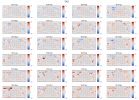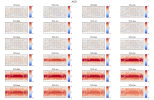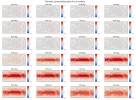Dear all,
I ran a simulation using CESM1.2.2 with CAM4 as the atmospheric component (compset B1850, resolution f19_g16). The simulation includes both a control experiment and a volcanic forcing experiment (both hybrid runs). The only difference between the two experiments is the inclusion of volcanic forcing in the latter:
&prescribed_volcaero_nl
prescribed_volcaero_datapath ='/public1/home/sc91441/cesm_inputdata/atm/cam/volc'
prescribed_volcaero_file ='EVA_eVolv2k_2000tgs_1811-1820.nc'
prescribed_volcaero_type ='SERIAL'
rad_climate = 'A:Q:H2O', 'N:O2:O2',
'N:CO2:CO2', 'N:ozone:O3',
'N:N2O:N2O', 'N:CH4:CH4',
'N:CFC11:CFC11', 'N:CFC12:CFC12',
'N:sulf:/public1/home/sc91441/cesm_inputdata/atm/cam/physprops/sulfate_camrt_c080918.nc', 'N:dust1:/public1/home/sc91441/cesm_inputdata/atm/cam/physprops/dust1_camrt_c080918.nc',
'N:dust2:/public1/home/sc91441/cesm_inputdata/atm/cam/physprops/dust2_camrt_c080918.nc', 'N:dust3:/public1/home/sc91441/cesm_inputdata/atm/cam/physprops/dust3_camrt_c080918.nc',
'N:dust4:/public1/home/sc91441/cesm_inputdata/atm/cam/physprops/dust4_camrt_c080918.nc', 'N:bcar1:/public1/home/sc91441/cesm_inputdata/atm/cam/physprops/bcpho_camrt_c080918.nc',
'N:bcar2:/public1/home/sc91441/cesm_inputdata/atm/cam/physprops/bcphi_camrt_c080918.nc', 'N:ocar1:/public1/home/sc91441/cesm_inputdata/atm/cam/physprops/ocpho_camrt_c080918.nc',
'N:ocar2:/public1/home/sc91441/cesm_inputdata/atm/cam/physprops/ocphi_camrt_c080918.nc', 'N:SSLTA:/public1/home/sc91441/cesm_inputdata/atm/cam/physprops/ssam_camrt_c080918.nc',
'N:SSLTC:/public1/home/sc91441/cesm_inputdata/atm/cam/physprops/sscm_camrt_c080918.nc', 'N:VOLC_MMR:/public1/home/sc91441/cesm_inputdata/atm/cam/physprops/sulfuricacid_cam3_c080918.nc'
However, in the volcanic forcing experiment, I am not observing the expected cooling. Instead, there seems to be an increase in the clearsky downwelling solar flux at the surface. I have attached my user_nl_cam file for reference.
Please let me know what changes are required, any suggestions would be greatly appreciated.
Thank you in advance for your help!
Best regards,
Yang
I ran a simulation using CESM1.2.2 with CAM4 as the atmospheric component (compset B1850, resolution f19_g16). The simulation includes both a control experiment and a volcanic forcing experiment (both hybrid runs). The only difference between the two experiments is the inclusion of volcanic forcing in the latter:
&prescribed_volcaero_nl
prescribed_volcaero_datapath ='/public1/home/sc91441/cesm_inputdata/atm/cam/volc'
prescribed_volcaero_file ='EVA_eVolv2k_2000tgs_1811-1820.nc'
prescribed_volcaero_type ='SERIAL'
rad_climate = 'A:Q:H2O', 'N:O2:O2',
'N:CO2:CO2', 'N:ozone:O3',
'N:N2O:N2O', 'N:CH4:CH4',
'N:CFC11:CFC11', 'N:CFC12:CFC12',
'N:sulf:/public1/home/sc91441/cesm_inputdata/atm/cam/physprops/sulfate_camrt_c080918.nc', 'N:dust1:/public1/home/sc91441/cesm_inputdata/atm/cam/physprops/dust1_camrt_c080918.nc',
'N:dust2:/public1/home/sc91441/cesm_inputdata/atm/cam/physprops/dust2_camrt_c080918.nc', 'N:dust3:/public1/home/sc91441/cesm_inputdata/atm/cam/physprops/dust3_camrt_c080918.nc',
'N:dust4:/public1/home/sc91441/cesm_inputdata/atm/cam/physprops/dust4_camrt_c080918.nc', 'N:bcar1:/public1/home/sc91441/cesm_inputdata/atm/cam/physprops/bcpho_camrt_c080918.nc',
'N:bcar2:/public1/home/sc91441/cesm_inputdata/atm/cam/physprops/bcphi_camrt_c080918.nc', 'N:ocar1:/public1/home/sc91441/cesm_inputdata/atm/cam/physprops/ocpho_camrt_c080918.nc',
'N:ocar2:/public1/home/sc91441/cesm_inputdata/atm/cam/physprops/ocphi_camrt_c080918.nc', 'N:SSLTA:/public1/home/sc91441/cesm_inputdata/atm/cam/physprops/ssam_camrt_c080918.nc',
'N:SSLTC:/public1/home/sc91441/cesm_inputdata/atm/cam/physprops/sscm_camrt_c080918.nc', 'N:VOLC_MMR:/public1/home/sc91441/cesm_inputdata/atm/cam/physprops/sulfuricacid_cam3_c080918.nc'
However, in the volcanic forcing experiment, I am not observing the expected cooling. Instead, there seems to be an increase in the clearsky downwelling solar flux at the surface. I have attached my user_nl_cam file for reference.
Please let me know what changes are required, any suggestions would be greatly appreciated.
Thank you in advance for your help!
Best regards,
Yang



